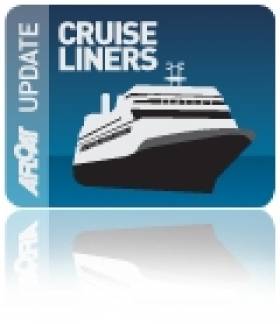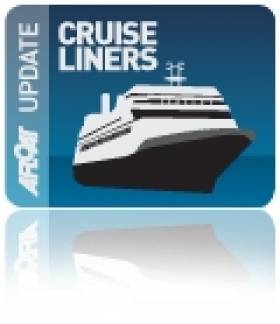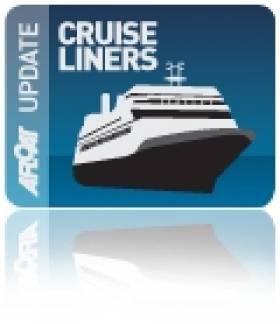Displaying items by tag: Cruise & Maritime Voyages
Cruise Caller Line-Up for Galway Harbour
#CRUISE LINERS- Galway Harbour can look forward to welcoming nine cruise calls to the mid-west port this year, with the first visitor being Arion which is scheduled to arrive in Galway Bay during late May, writes Jehan Ashmore.
Arion harks back to an era of the more classically designed ships with graceful sweeping lines. The 5,888 tonnes veteran vessel was launched in 1965 at Pula, in Croatia, as Istra and later in her career she underwent a major reconstruction in a Lisbon shipyard during 2000.
Cruise & Maritime Voyages (CMV) will be sending their Marco Polo, another classic veteran, in July as part of a 12 night 'Emerald Isle' discovery cruise departing Tilbury, with en-route calls to Cobh and Glengariff the previous day.
For a full listing of the cruise-calls schedule click HERE.
Dublin Port Turn-Around Offers Direct Cruises to the Sun
With a short-turn around in port, more cruise-goers will be boarding for a mid-afternoon departure, marking the start of a 13-night Canary Islands & Madeira cruise. When she heads out of the port, the first port of call is Falmouth then it's off to Leixoes (Portugal), Agadir (Morocco), Arrecife (Lanzarote), Las Palmas (Gran Canaria), Funchal (Madeira), Lisbon (Portugal) and Vigo (Spain) before returning to Dublin.
The vessels final end-of season cruise from Dublin is on 25 October, with a 10-night cruise to Nice (returning by air). The interim ports of call are to Falmouth, Leixoes, Lisbon, Cartagena (Spain) Palma and Mahon (Menorca). To read more about this cruise click HERE.
In addition to Dublin calls the former Cunard Countess, also called this season to Cork Harbour. It was during a call last month to Ringaskiddy that another 'Cunarder' the flagship, Queen Mary 2 was also in port on a call to Cobh. To read more of that visit click HERE.
Brand New Marina Calls to Dublin
The cruise started from Copenhagen and toured several ports in Norway from where the vessel continued to Lerwick, Torshavn,Iceland, Portree and her last port of call was Belfast. The vessel had berthed in Dublin's Alexandra Basin and departed this evening bound for Dover.
Following the Marina's departure out of Dublin Bay via the North Burford bouy, was the Marco Polo. The 1965 built vessel operates for Cruise and Maritime Voyages and she proceeded past the South Burford bouy bound for St. Mary's, the capital of the Scilly Isles.
There will be many more cruisecalls such as the ultra luxury six-star Silver Cloud which is due on Sunday. The 16,927 tonnes vessel operated by Italian owned SilverSeas Cruises, has only a capacity for 294 passengers. Following that visit P&O Cruises 115,000 tonnes Azura docks in the capital this day next week to disembark up to 3,500 passengers. To view a full list of cruise callers click HERE.
Former Soviet-Bloc Liner Continues Cruising
Cruising off the east coast of Leinster this evening is the veteran cruiseship Marco Polo which is bound for the Scilly Isles off Land's End, writes Jehan Ashmore.
For those with an appreciation for the more traditional tiered deck profile compared to the bulky new giant cruiseships, the 22,080 tonnes vessel built as the Aleksandr Puskin at the Mathias-Thesen-Werft, East Germany, certainly represents a different era.
The liner entered service in 1966 with the Baltic Shipping Company on their regular trans-Atlantic Montreal-Leningrad service. In 1975 she was converted for her new role as a full-time cruiseship. For a cut-away deck profile and description of facilities click here.
She can take 850 passengers accommodated in 450 cabins. Her main dimensions reflect her ocean-going design noting her draft is 8.2m (26.9ft) with a length of 176.3m (578.4ft) and a beam of 23.6m (77.4ft). Crewing is divided between senior officers (international) and cruise staff and entertainers are both British and comprising of other nationalities.
In recent years Marco Polo served the German market but she now is run by Cruise & Maritime Voyages (CMV) on cruises from the UK. The company also operate the Ocean Countess which first started out her days as Cunard Countess.
Cruise-Talk at the Holiday World Show
The following ferry and cruise operators are exhibiting at the show: Azamara Cruises, Celebrity Cruises, Celtic Link Ferries, Cruise & Maritime Voyages, Cruise Holidays, Travel.ie, Hurtigruten, John Galligan Travel, MSC Cruises, Princess Cruise Lines, Pullmantur Cruises, Regent Seven Seas Cruises, Royal Caribbean Cruise Line, Saga, Silversea Cruises, Thomas Cook and Voyages To Antiquity.
Also exhibiting is Emerald Star for those interested in taking a cabin-cruiser holiday on the Shannon.
For opening times of Holiday World Show (incorporating the Caravan & Motor Home Show) see below
Friday 28 January 1.00 pm - 8.00 pm
Saturday 29 January 11.00 am - 5.30 pm
Sunday 30 January 11.00 am - 5.30 pm
For a full listing of exhibitors, ticket prices and further information about the show logon to www.holidayworldshow.com
Come Cruising at the Holiday World Shows
The following ferry, cruise and specialist travel companies exhibiting at the Belfast venue are: DFDS Seaways (formerly Norfolkline), Celebrity Cruises, Complete Cruise Solution, Cruise & Maritime Voyages, Cunard, Norwegian Cruise Line, P&O, Princess, Pullmantur Cruises, Regent Seven Seas Cruises, Royal Caribbean Cruise Line, Seabourn, Silverseas Cruises, The Cruise Machine (trading as Vamos Holidays) and Voyages To Antiquity.
On the following weekend, The Holiday World Show in association with The Sunday Times will be held on 28, 29 and 30 January at the RDS Simmonscourt, Dublin, which incorporates the Caravan & Motor Home Show.
Like the Belfast show The World World Show in Dublin will have numerous exhibitors with worldwide destinations and all types of holidays on show. The following ferry, cruise and specialist travel operators will be exhibiting: Azamara Cruises, Celebrity Cruises, Celtic Link Ferries, Cruise & Maritime Voyages, Cruise Holidays, Travel.ie, Hurtigruten, John Galligan Travel, MSC Cruises, Princess Cruise Lines, Pullmantur Cruises, Regent Seven Seas Cruises, Royal Caribbean Cruise Line, Saga, Silversea Cruises, Thomas Cook and Voyages To Antiquity. Also at the show will be Emerald Star for those interested in taking a cabin-cruiser holiday on the Shannon.
Visitors to the Holiday World Show Dublin can attend cruise talks hosted by the Eoghan Corry Free Expert Clinics during the three-day long show. For a full listing of exhibitors, ticket prices, opening hours and further information about both shows logon to www.holidayworldshow.com


































































